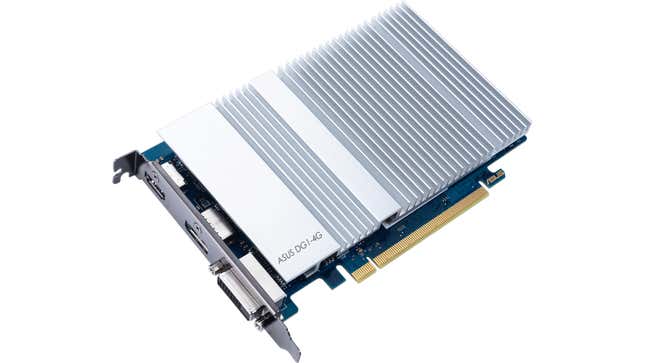
It’s been more than 20 years since Intel released its last desktop graphics card, the Intel740, but as of yesterday the company is officially back in the discrete GPU game.
Intel teamed up with Asus and a few other graphics cards partners to release its Iris Xe desktop GPUs for system builders who want to include the new card in their prebuilt PCs. The cards look a lot different from the prototype Intel showed off at CES 2020, especially the ones being provided from manufacturers other than Asus.
These new cards, originally codenamed DG1, are part of Intel’s Iris Xe graphics family, which power the 11th-gen Tiger Lake processors. The company has planned for a while time to release multiple desktop solutions, but Intel is still working on its Xe-HPG architecture, which will power the company’s future gaming GPUs and ideally rival Nvidia and AMD.
The cards that Intel just released are not your gaming-grade GPUs from the likes of Nvidia and AMD. Intel says these Iris Xe desktop cards were designed to give value desktop PCs “improved graphics, display, and media acceleration capabilities.” And the spec list seems to suggest just that: three display outputs; hardware video decode and encode acceleration, including AV1 decode support; Display HDR support and artificial intelligence capabilities; and 80 execution units (EUs)and 4 GB of video memory.
In other words, these new GPUs seem targeted more toward business or education-focused desktop PCs. (Dell is the first company that comes to mind.) Intel previously said that its Xe graphics will have up to 96 EUs, so these desktop GPUs could be the last stop Intel has to make before it releases its gaming-focused cards.
This past summer, Intel confirmed that its gaming-tier GPUs will have hardware accelerated ray tracing. At CES 2021 the company said it was working on a way to enable both integrated and discrete graphics at the same time on PCs, which would allow users to maximize the discrete GPU for gaming and offload other tasks like streaming and recording to the integrated GPU. It’s also working with Nvidia to implement Resizable BAR on Intel CPU/Nvidia GPU combos, so users can get a frame rate boost out of certain games.
But if Intel is working on that with Nvidia, they could potentially make their CPUs and GPUs talk to each other as well, just like AMD’s Smart Access Memory. Combined with simultaneously harnessing the power of a discrete and integrated GPU, not to mention ray tracing, that makes a compelling case for Intel being able to compete with Nvidia and AMD’s graphics cards. In the meantime, how well these DG1 cards perform as part of a complete system could very well set the expectations for Intel’s gaming GPUs.